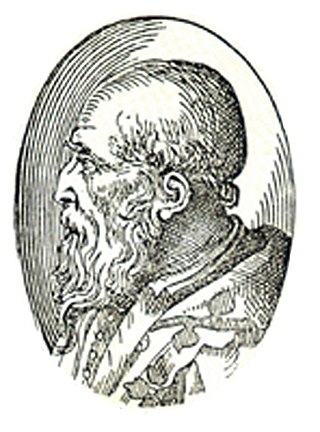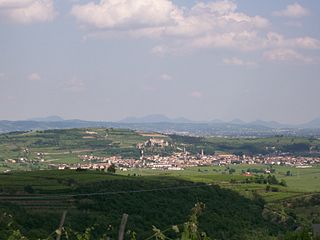
The Doge's Palace is a palace built in Venetian Gothic style, and one of the main landmarks of the city of Venice in northern Italy. The palace was the residence of the Doge of Venice, the supreme authority of the former Republic of Venice. It was built in 1340 and extended and modified in the following centuries. It became a museum in 1923 and is one of the 11 museums run by the Fondazione Musei Civici di Venezia.

The Contarini is one of the founding families of Venice and one of the oldest families of the Italian Nobility. In total eight Doges to the Republic of Venice emerged from this family, as well as 44 Procurators of San Marco, numerous ambassadors, diplomats and other notables. Among the ruling families of the republic, they held the most seats in the Great Council of Venice from the period before the Serrata del Maggior Consiglio when Councillors were elected annually to the end of the republic in 1797. The Contarini claimed to be of Roman origin through their patrilineal descendance of the Aurelii Cottae, a branch of the Roman family Aurelia, and traditionally trace their lineage back to Gaius Aurelius Cotta, consul of the Roman Republic in 252 BC and 248 BC.

Michele Sanmicheli, sometimes also transcribed as Sammicheli, Sanmichele or Sammichele, was an Italian architect and urban planner who was a citizen of the Republic of Venice.

Francesco Barbaro (1390–1454) was an Italian politician, diplomat, and humanist from Venice and a member of the patrician Barbaro family. He is interred in the Church of the Frari, Venice.

The Barbaro family was a patrician family of Venice. They were wealthy and influential and owned large estates in the Veneto above Treviso. Various members were noted as church leaders, diplomats, patrons of the arts, military commanders, philosophers, scholars, and scientists.

Soave is a small comune of the Veneto region in the Province of Verona, northern Italy, with a population of roughly 6,800 people.

Sant'Ambrogio di Valpolicella is a comune (municipality) in the Province of Verona in the Italian region Veneto, located about 120 kilometres west of Venice and about 15 km (9 mi) northwest of Verona.

Antonio Balestra was an Italian painter of the Rococo period.

The House of Carrara or Carraresi (da Carrara) was an important family of northern Italy in the 12th to 15th centuries. The family held the title of Lords of Padua from 1318 to 1405.

Ubertino Ida Carrara, called Novello and better known as Ubertinello, was the Lord of Padua from 1338 until his death.

The Veronese Easter was a rebellion during the Italian campaign of 1797, in which inhabitants of Verona and the surrounding areas revolted against the French occupying forces under Antoine Balland, while Napoleon Bonaparte was fighting in Austria. The uprising received its name through association with the anti-French uprising of the Sicilian Vespers of the 13th century. Incited by oppressive behaviour by the French, it began on the morning of 17 April 1797, the second day of Easter: the enraged population succeeded in defeating more than a thousand French soldiers in the first hour of fighting, forcing them to take refuge in the town's fortifications, which the mob then captured by force. The revolt ended on 25 April 1797 with the encirclement and capture of the town by 15,000 soldiers, who then forced it to pay a huge fine and hand over various assets, including artwork.

The Domini di Terraferma was the hinterland territories of the Republic of Venice beyond the Adriatic coast in Northeast Italy. They were one of the three subdivisions of the Republic's possessions, the other two being the original Dogado (Duchy) and the Stato da Màr.
Venetian literature is the corpus of literature in Venetian, the vernacular language of the region roughly corresponding to Venice, from the 12th century. Venetian literature, after an initial period of splendour in the sixteenth century with the success of artists such as Ruzante, reached its zenith in the eighteenth century, thanks to its greatest exponent, dramatist Carlo Goldoni. Subsequently, the literary production in Venetian underwent a period of decline following the collapse of the Republic of Venice, but survived nonetheless into the twentieth century to reach peaks with wonderful lyrical poets such as Biagio Marin of Grado.
The following is a timeline of the history of the city of Padua in the Veneto region of Italy.
The following is a timeline of the history of the city of Verona in the Veneto region of Italy.

Galeas per montes is the name given to a feat of military engineering made between December 1438 and April 1439 by the Republic of Venice, when several Venetian ships, including galleys and frigates were transported from the Adriatic Sea to Lake Garda. The operation required towing the ships upstream on the river Adige until Rovereto, then transporting the fleet by land to Torbole, on the Northern shores of the lake. The second leg of the journey was the most remarkable achievement, requiring a land journey 20 km through the Loppio Lake and the narrow Passo San Giovanni.

The Riformatori dello studio di Padova, also Riformatori allo studio di Padova, were the three officials of the Venetian Republic responsible for overseeing education and culture. Created in 1517, initially to reopen the University of Padua after the War of the League of Cambrai, they became responsible over time for public and private schooling at all levels, public libraries in Venice and Padua, intellectual academies, and professional schools. They also reviewed and authorized for publication all books within the mainland territory of Venice.
Giuseppe Fiocco was an Italian art historian, art critic, and academic. He is known for his research and writings on Venetian and Florentine artists.

The War of Padua was a conflict in 1404–1405 between the Republic of Venice and the Carrarese lordship of Padua. In the power vacuum produced by the death of the Duke of Milan, Gian Galeazzo Visconti, in 1402, Francesco II da Carrara endeavored to expand into the Veneto and capture cities held by Visconti troops. These designs alarmed Venice, which allied with Milan to counter the common threat posed by the Carrarese state, and for the first time adopted a policy of direct intervention in the affairs of its hinterland.

The Vicariate of Valpolicella was an administrative entity created under the Venetian Republic following Verona's devotion to Venice in 1405, encompassing the Valpolicella territories that already constituted the County of Valpolicella established in the previous century by the Scaligers.















